Green Week, Brussels, 23-27 April 2001
The role of the European
Environment Agency in delivering information to support the policy
process
Domingo
Jiménez-Beltrán
Executive Director
European Environment Agency
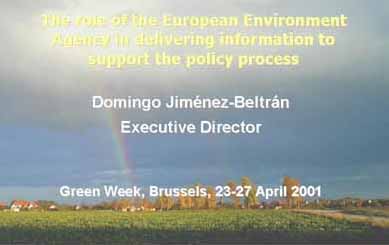 |
| The European Environment Agency (EEA) is a
European Community institution with the aim of serving the Community
and the Member States with information to support policy making for
environmental protection put in the perspective of sustainable
development. We do that by collecting and assessing data on the current
and foreseeable state of the environment. With the development in
attention going from ‘environment', to the environmental pillar in
sustainable development' to ‘environmentally sustainable development'
we are in a constant process of creating clear lines for our clients
focusing on the essentials in the overload of environmental and
sustainability information. |
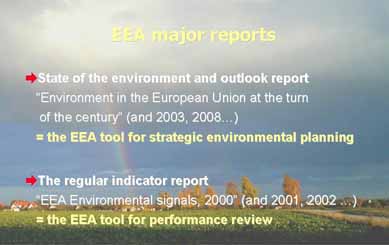 |
| Over the past six years, the EEA has published
five major comprehensive environmental reports. At the beginning of a
new EU policy cycle (re. Helsinki Council's conclusions; 6th EAP), it
is necessary to develop a strategy and plan for the Agency's main
periodical reporting over the next period. The main aim is to present
key environmental indicators in order to report, on a regular and
consistent basis, on progress in a number of policy areas at the
European level. |
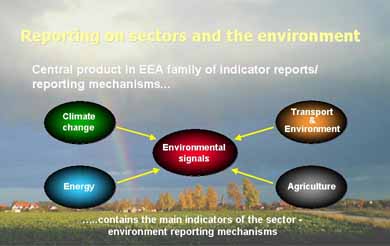 |
| In recent years the discussions on environmental
indicators have broadened from indicators for describing changes in the
state of the environment to an interrelated family of indicator sets.
In line with the broadening of environmental policy from dealing with
environmental media or environmental problems to the integration of
environment into other policy fields, indicators for sectors and the
environment have been developed. These show interlinkages between
activities of societal sectors (transport, energy, forestry, etc) and
the environment. |
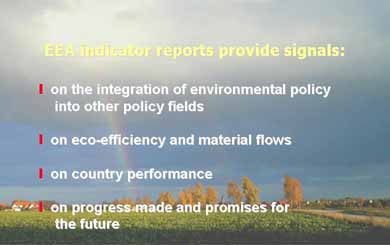 |
| Indicators are important because we can manage
only what we can measure. And while critics may argue that indicators
and targets are a far too simplistic response to complex issues, the
reality is that they appear to work! At the EEA we face a constant
challenge to prevent overload of information on the environment and
sustainability, and indicators are a key tool for us in this regard
since they distil data into a clear and accessible form. |
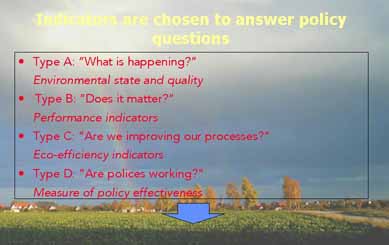 |
| Indicators should not be solely presentations of
statistics on the state of the environment but should form part of an
analysis of progress made under the socio-economic and policy contexts.
This means that as far as possible indicators should be developed as:
· Performance indicators, linked to an agreed policy target
· Efficiency indicators, which show the relationship to
production and other economic variables · Policy effectiveness
indicators, which show the effect of policy measures and structural
developments. Some examples of these types of indicators are given
below: |
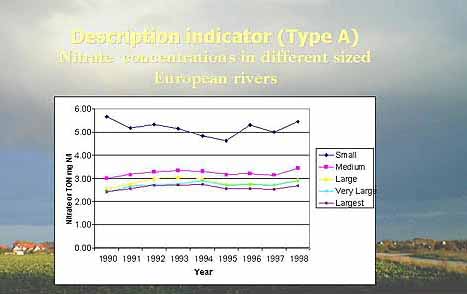 |
This type of indicator allows for a key message
such as:
 Nitrate concentrations
have not changed. The high concentrations in smaller rivers reflect the
impact of agriculture. Nitrate concentrations
have not changed. The high concentrations in smaller rivers reflect the
impact of agriculture. |
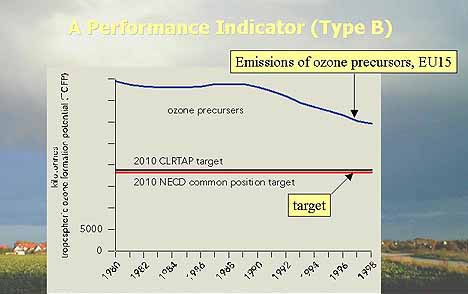 |
|
This type of indicator allows for a key message such as:
 Emissions of
ozone-forming gases (ozone precursors) have fallen by 22 % since 1990,
mainly due to introduction of catalysts on new cars. However, emission
targets for VOCs and NOx set in the fifth environmental action
programme have not been reached, and substantial reductions of
non-methane volatile organic compounds and nitrogen oxides are still
required to achieve 2010 targets. Emissions of
ozone-forming gases (ozone precursors) have fallen by 22 % since 1990,
mainly due to introduction of catalysts on new cars. However, emission
targets for VOCs and NOx set in the fifth environmental action
programme have not been reached, and substantial reductions of
non-methane volatile organic compounds and nitrogen oxides are still
required to achieve 2010 targets.
|
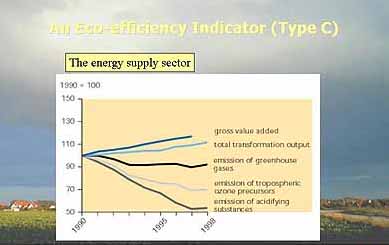 |
|
This type of indicator allows for a key message such as:
 While the output of
the sector has grown, emissions to the air have fallen. However, the
decrease in emissions ceased in 1998. While the output of
the sector has grown, emissions to the air have fallen. However, the
decrease in emissions ceased in 1998.
 Carbon intensity of
electricity generation from fossil fuels in the EU15 has decreased,
however action is required to ensure further reductions in line with
obligations under the Kyoto Protocol. Carbon intensity of
electricity generation from fossil fuels in the EU15 has decreased,
however action is required to ensure further reductions in line with
obligations under the Kyoto Protocol.
|
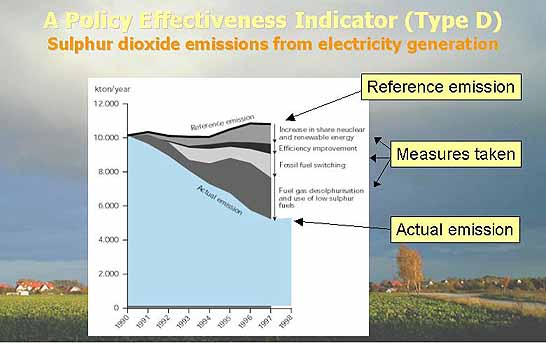 |
This type of indicator allows for a key message
such as:
 About half of the
decrease in emissions of sulphur dioxide emissions from power plants
can be attributed to the introduction of flue gas desulphurisation and
the use of lower sulphur coals and fuel oils in conventional thermal
power plants. About half of the
decrease in emissions of sulphur dioxide emissions from power plants
can be attributed to the introduction of flue gas desulphurisation and
the use of lower sulphur coals and fuel oils in conventional thermal
power plants. |
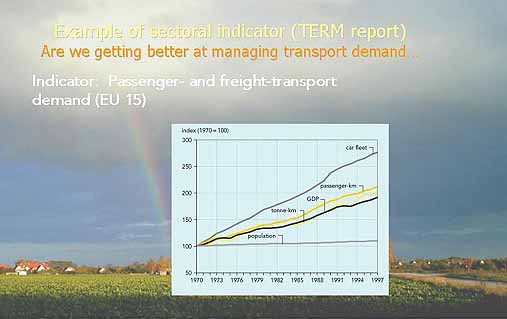 |
Recently, policy makers have given considerable
attention to the development of indicators as they are an integrated
part of the development of sectoral strategies for the integration of
environmental concerns into their policies. Most of the sectoral
strategies submitted for the European Council in Helsinki (December
1999) mentioned explicitly the development of indicators and reporting
mechanisms based on indicators.
For transport and environment a list of 30 indicators has been agreed
and the indicators produced. The Transport and Environment Reporting
Mechanism (TERM) developed by the EEA with the support of Eurostat and
the other European Commission services is a good example of such
monitoring. Together with its partners, the EEA is now developing
similar indicator-based reports on energy and on agriculture. |
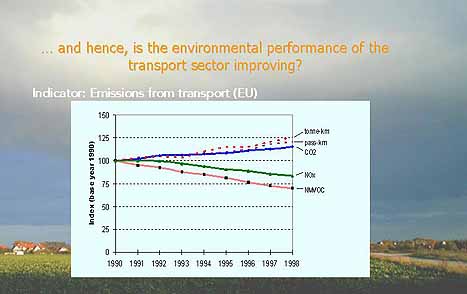 |
Following that approach, a regular assessment of
the transport/environment issues can be delivered, allowing comparisons
over time, such as:
"Transport is the fastest-growing source of anthropogenic carbon
dioxide emissions. The main cause of this is the continuing growth in
road transport, but emissions from aviation are also growing rapidly.
Little progress is being made in internalising the external
environmental and other costs of transport: the more environmentally
harmful modes are often still the cheapest and the most attractive in
terms of quality and flexibility. In particular, current price
structures continue to favour private over public transport." |
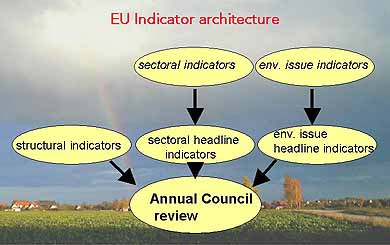 |
| Assuming that policy developers in the EU aim at a
rational and efficient set of policies we may expect that under the
sustainable development strategy a number of interlinked and mutually
supporting policies will emerge. Clear structures are needed to
communicate to policy makers how the information that we provide is
related to policy processes and to make clear what type of information
serves which process. For that purpose, clusters of environmental
indicators are being developed. |
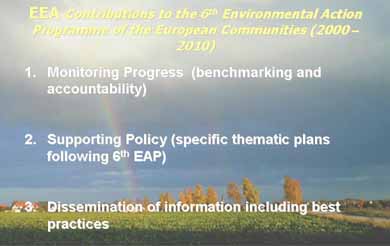 |
As well, the 6th environmental action programme
and envisaged specific action plans to achieve environmental
sustainability need to be monitored using sets of selected issue
indicators. The EEA is currently developing proposals for these and its
Environmental Signals report series will develop into the main
indicator report on environmental sustainability.
The 6th EAP tries to establish not only the environmental
sustainability pillar of the Sustainable Development Strategy but also
to define the accompanying accountability (monitoring and reporting),
all that in a time perspective of year 2010. Analysing best practices
in this context also represents an important information which
dissemination to the the 'doers' (business, local authorities, …) is in
the remit of the EEA. |
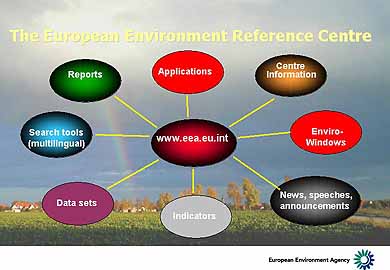 |
The role of the EEA is therefore to offer the
service of the Europe's gateway to environmental information, of
various types, formats and purposes.
You are more than welcome to visit our Web site: http://www.eea.europa.eu. |
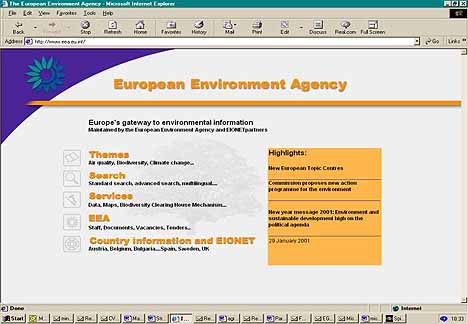 |
| |
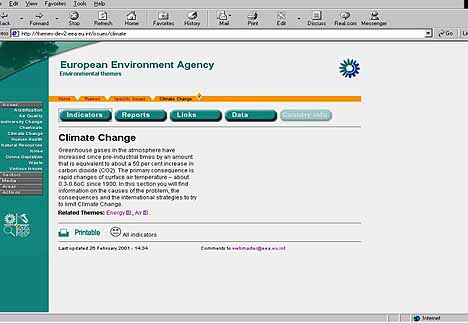 |
| |
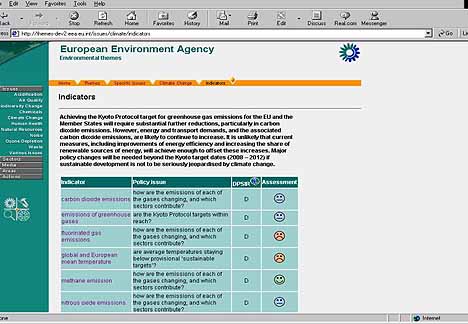 |


















Document Actions
Share with others